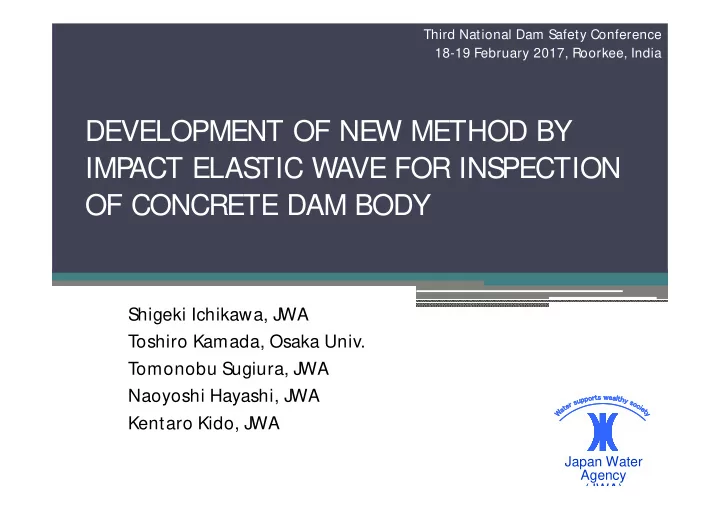

Third National Dam Safety Conference 18-19 February 2017, Roorkee, India DEVELOPMENT OF NEW METHOD BY IMP ACT ELAS TIC WAVE FOR INS PECTION OF CONCRETE DAM BODY Shigeki Ichikawa, JWA Toshiro Kamada, Osaka Univ. Tomonobu Sugiura, JWA Naoyoshi Hayashi, JWA Kentaro Kido, JWA Japan Water Incorporated Administrative Agency Incorporated Administrative Agency Japan Water Agency Japan Water Agency Agency (JWA)
Incorporated Administrative Agency Incorporated Administrative Agency Japan Water Agency Japan Water Agency Introduction Degradation of the horizontal construction joint faces of a dam body • Negative affects the stability of the body • Deterioration of a concrete dam that arises due to aging Boring survey • High cost • Damage inflicted to the dam body • Single point inspection • Insufficient for investigating the total extent of degradation Nondestructive inspection technique for surveying a dam body by using reflection of impact elastic waves 2
Incorporated Administrative Agency Incorporated Administrative Agency Japan Water Agency Japan Water Agency S urvey Target Dam Survey target dam; • JWA‘s concrete gravity dam • height of 42 m, crest length of 138 m • completed in 1975 (41 years ago) Jan. 1977 Waterstop Horizontal Construction Joint Reservoir Crack Transverse Joint (Possible leakage path in dam body) Mar. 2008 3
Incorporated Administrative Agency Incorporated Administrative Agency Japan Water Agency Japan Water Agency The Impact Elastic Wave Method (IEWM) Impact is applied to each point on the dam crest 4
Incorporated Administrative Agency Incorporated Administrative Agency Japan Water Agency Japan Water Agency Categorizing the Measured Waveforms Pattern A Single Impact M easured Waveform No reflection was Passing observed at the through evaluation depth Construction Joint No cracks Reflection definitely (separation) observed at a depth deeper than the evaluation depth Bottom Longitudinal wave (Compressional wave) 5
Incorporated Administrative Agency Incorporated Administrative Agency Japan Water Agency Japan Water Agency Categorizing the Measured Waveforms Pattern B M easured Waveform Reflection observed at the evaluation depth but elastic wave passing M ixture of through (propagating) passing deeper than the through and evaluation depth reflection Construction Joint Partial cracks Reflection definitely (separation) observed at a depth deeper than the evaluation depth Bottom 6
Incorporated Administrative Agency Incorporated Administrative Agency Japan Water Agency Japan Water Agency Categorizing the Measured Waveforms Pattern C M easured Waveform Reflection observed at Only reflection the evaluation depth and no passing and no reflection found through deeper than the Construction Joint evaluation depth Continuous cracks No waveform (separation) Bottom 7
Associating Measurement Results with the Incorporated Administrative Agency Incorporated Administrative Agency Japan Water Agency Japan Water Agency S tate of the Construction Joint Face Category Assumed State of the Joint Face around a M easuring Point No separation or separation has been completely sealed with filling etc., leaving no Type I gaps. The waveform is classified into Pattern A. The major parts are the same as Type I, but partly separated, which generates gaps. Type II The waveform is classified into Pattern B. Parts are the same as Type I, but the rest is separated, which generates gaps. Type III The waveform is classified into Pattern B. M ajor parts are separated, which generates continuous gaps. Type IV The waveform is classified into Pattern C. 8
Relevancy Indices for Estimation of the S tate Incorporated Administrative Agency Incorporated Administrative Agency Japan Water Agency Japan Water Agency of Construction Joint Ten or more waveforms were collected at each point, and the state of each point was categorized based on the percentage of occurrence of each waveform pattern (A – C). Based on the results of the IEWM of the 62 points for which the actual state had been confirmed in the boring survey, relevancy indices for estimating the type of construction joint face (I - IV) from the rate of each pattern was determined. Category Rate of Waveform Patterns Type I 80% < A and C = 0% 0 < A ≤ 80% and C = 0%, or Type II 0 < C ≤ 20% 20 < C ≤ 80%, or Type III 0 < A ≤ 20% and 80% ≤ C A = 0% and 80% ≤ C Type IV 9
Estimation of Horizontal Construction Joint Incorporated Administrative Agency Incorporated Administrative Agency Japan Water Agency Japan Water Agency Faces from Measurement Results It is possible to estimate the state of each point on the grid regarding the target faces using the rate of each waveform pattern of the target construction joint face and the relevancy indices for estimating the state of construction joint. Type I Type II Type III Type IV Sample Estimation of the State of a Horizontal Construction Joint Face 10
Incorporated Administrative Agency Incorporated Administrative Agency Japan Water Agency Japan Water Agency Conclusions IEWM can reveal a range of degradation with regard to the horizontal construction joint faces of a concrete dam body. IEWM is expected to be an effective method for quantitative evaluation of the state of horizontal joint and utilization to review the soundness of concrete dam body. For further improvement; • Laboratory tests of large specimens with artificial defects such as inside cracks • Surveying from the inspection gallery inside the dam body • M easurements of other dam bodies Thank you for your attention. 11
Recommend
More recommend